Bitter Moon

Introducing Bitter Moon (1992) – A Comprehensive Overview
A Provocative Polanski Masterpiece of Love and Obsession
Bitter Moon (1992), directed by Roman Polanski, is a Franco-British-American *** that delves into the dark complexities of love, lust, betrayal, and obsession. Adapted from Pascal Bruckner’s novel Lunes de fiel (translated as Evil Angels in English), the film stars Peter Coyote, Emmanuelle Seigner, Hugh Grant, and Kristin Scott Thomas, weaving a tale of two couples whose lives intertwine on a Mediterranean cruise. Released on September 23, 1992, in France and March 18, 1994, in the United States, Bitter Moon is a polarizing entry in Polanski’s oeuvre, celebrated for its audacious exploration of sexual perversion and psychological depth but criticized for its melodramatic excess and controversial themes. With a haunting score by Vangelis and Polanski’s signature claustrophobic direction, the film remains a cult classic, sparking debate over its provocative narrative and moral ambiguities. This article provides a comprehensive exploration of the film’s narrative, cast, production, themes, reception, and cultural significance, offering a complete introduction to its enduring, if divisive, legacy .
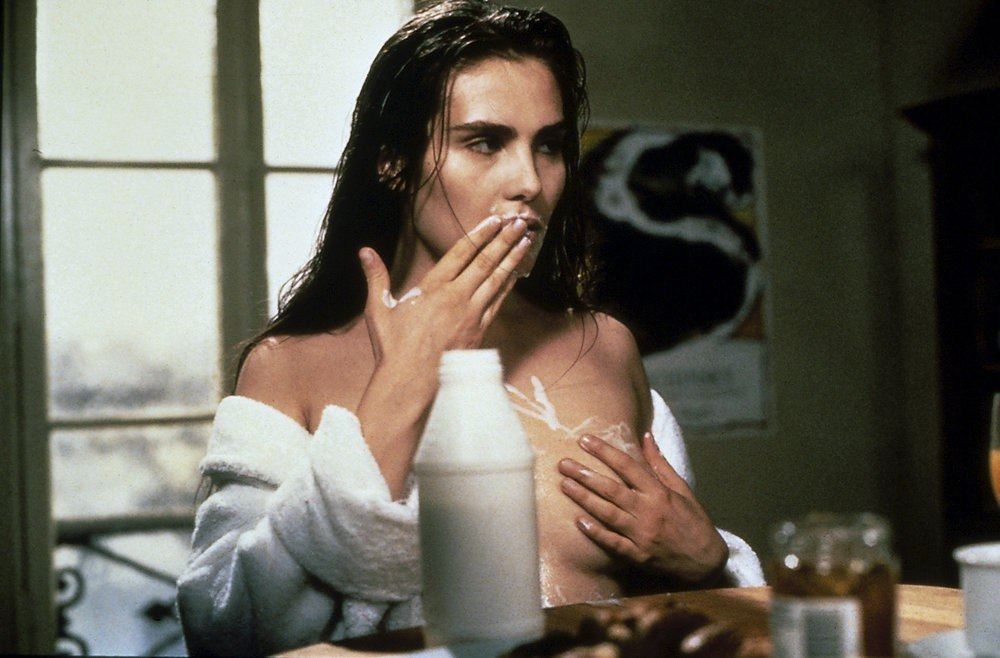
Synopsis: A Cruise Through Love’s Dark Abyss
Set in the early 1990s, Bitter Moon unfolds aboard a luxury cruise ship sailing from Southampton to Istanbul, en route to India. Nigel Dobson (Hugh Grant) and his wife Fiona (Kristin Scott Thomas), a well-to-do British couple celebrating their seventh wedding anniversary, embody a stable but passionless marriage. Their attempt to rekindle romance is disrupted when Nigel encounters Mimi (Emmanuelle Seigner), a mesmerizing young French woman dancing alone in the ship’s bar. Intrigued by her beauty and vulnerability, Nigel is drawn into a fateful interaction when he meets her older, paraplegic American husband, Oscar Benton (Peter Coyote), a failed writer whose acerbic cynicism masks deep wounds .
Oscar, confined to a wheelchair, invites Nigel to his cabin and begins narrating the ***, a tale he recounts with unsettling relish. Through extended flashbacks, set in a vibrant 1980s Paris, Oscar describes meeting Mimi, then a 20-year-old dancer, on a bus. Their passionate romance quickly spirals into ***, marked by ***. As their lust consumes them, the relationship turns toxic—Mimi’s dependence clashes with Oscar’s cruelty, leading to ***. After two years of debauchery, Oscar, bored, abandons Mimi on a flight to Martinique, only to suffer a near-fatal accident that leaves him paraplegic. Mimi returns, ostensibly to care for him, but exacts revenge by paralyzing him further, forcing a twisted co-dependency that culminates in their marriage
Back on the cruise, Nigel becomes infatuated with Mimi, who ***, while Fiona, sensing his distraction, flirts with a younger man, warning Nigel, “Anything you can do, I can do better.” Oscar’s narration, laced with voyeuristic detail, manipulates Nigel’s fascination, drawing him into their perverse dynamic. The narrative builds to a climactic New Year’s Eve party, where boundaries of love, fidelity, and morality are shattered in a shocking, tragic resolution that leaves both couples forever changed. Running at 139 minutes, Bitter Moon is a darkly comic, psychologically knotty voyage that challenges viewers to confront the extremes of human desire .
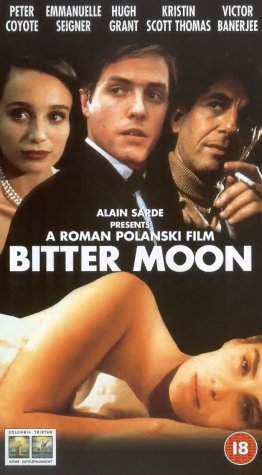
Cast and Performances: A Quartet of Compelling Contrasts
The performances in Bitter Moon are a cornerstone of its impact, with each actor delivering a distinct facet of the film’s emotional spectrum. Peter Coyote, as Oscar Benton, dominates with a tour-de-force portrayal, his “abominable” yet magnetic character chewing the scenery with gleeful cynicism, per IMDb [web:0]. Coyote’s narration, described by Roger Ebert as “voracious,” blends wit, malice, and pathos, making Oscar both repulsive and captivating, particularly in scenes of depravity like the milk-drinking sequence set to George Michael’s “Faith” . His ability to embody Oscar’s arc—from charming bohemian to broken sadist—earned Rotten Tomatoes’ praise for “shining” amidst melodrama .
Emmanuelle Seigner, as Mimi, delivers a haunting performance as the seductive yet vulnerable femme fatale. Polanski’s real-life wife, Seigner’s role sparked controversy for its autobiographical undertones, but her “sumptuous beauty” and “complete wreck” transformation, per IMDb, showcase remarkable range [web:6]. Hollywood Screen & Stream Review lauds her “poignantly haunting” vulnerability, though Letterboxd notes her ***. Her dance scenes, especially in a red mini-dress to Bryan Ferry’s “Slave to Love,” are iconic, per Luke Honey’s Substack .
Hugh Grant, as Nigel Dobson, plays against type as a repressed, bumbling Brit, his “little bitch” persona, per Letterboxd, providing comic relief and a foil to Coyote’s intensity [web:5]. Time Out praises Grant’s “terribly nice” awkwardness, though Variety finds him “miscast” in the darker moments . Kristin Scott Thomas, as Fiona, brings icy elegance and understated strength, her “cool and distanced” poise, per Amazon’s German review, grounding the couple’s unraveling marriage . Her climactic scenes, per TV Tropes, reveal a fierce agency, stealing focus . Supporting roles, like Victor Banerjee as a philosophical passenger and Sophie Patel as his daughter, add texture, per AllMovie . The quartet’s interplay, described by BFI as “wickedly comic,” drives the film’s psychological tension.
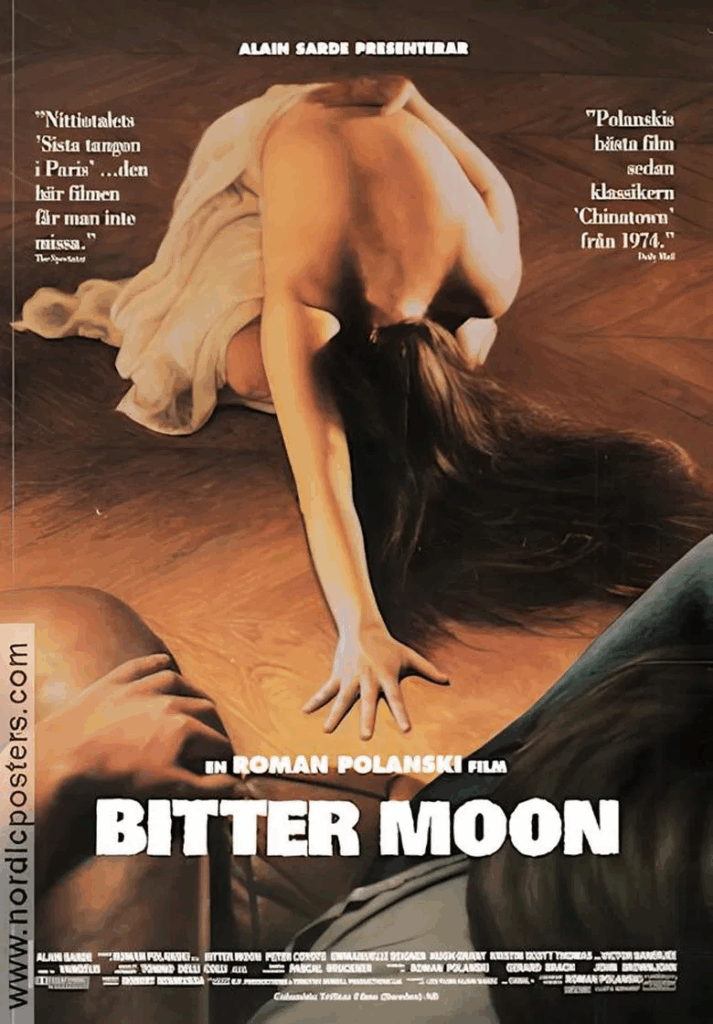
Production: Polanski’s Audacious Vision
Directed by Roman Polanski, Bitter Moon was co-written by Polanski, Gérard Brach, John Brownjohn, and Jeff Gross, adapting Pascal Bruckner’s 1981 novel Lunes de fiel (meaning “bile moon,” a pun on “honeymoon”). Produced by Canal+, Columbia Pictures, and others with a budget estimated at $5-10 million, the film was shot in 1991 across Paris, Southampton, and Mediterranean cruise sets, capturing a claustrophobic yet opulent aesthetic . Cinematographer Tonino Delli Colli, a Polanski regular, used a lush, vibrant palette for Paris flashbacks—reds, golds—and a colder, blue-gray tone for the ship, enhancing the narrative’s emotional shifts, per Kino Lorber . Hervé de Luze’s editing weaves complex flashbacks seamlessly, earning IMDb’s praise for “sophisticated” pacing .
Vangelis’s score, blending orchestral swells and eerie synths, underscores the film’s seductive yet menacing tone, described by IMDb as “wondrous” [web:6]. Production design by Pierre Guffroy, with Paris apartments and the cruise’s art deco interiors, contrasts bohemian chaos with sterile luxury, per AllMovie [web:11]. Costume design by Jacques Schmidt, particularly Mimi’s red mini-dress and Fiona’s elegant gowns, amplifies character dynamics, per Luke Honey . Challenges included navigating the film’s explicit content—graphic sex, S&M—for an R rating (18 in the UK), with India’s CBFC cutting three minutes, per IMDb [web:6]. Casting Polanski’s wife, Seigner, fueled controversy, with The New York Times noting perceived “lurid autobiography” . Premiering at the Venice Film Festival in 1992, it faced a mixed reception, leading to a limited U.S. release in 1994, per Box Office Mojo .

Themes and Symbolism: Love, Obsession, and Moral Ambiguity
Bitter Moon explores themes of obsessive love, ***, betrayal, and moral hypocrisy, using its dual couples to probe the extremes of human relationships. Oscar and Mimi’s relationship, described by Time Out as a “grotesque portrait of love’s variety,” descends from passionate romance to sadomasochistic torment, critiquing the destructive nature of unchecked desire . Nigel and Fiona’s staid marriage, per Hollywood Screen & Stream, serves as a foil, exposing repressed urges and societal facades. The film questions the boundaries of love versus lust, with Polanski suggesting, per Roger Ebert, that physical passion is fleeting, requiring deeper bonds to endure .
Power dynamics and manipulation are central, with Mimi’s shift from victim to tormentor and Oscar’s voyeuristic narration over Nigel reflecting gendered control, per TV Tropes . The cruise ship, a claustrophobic microcosm, symbolizes entrapment, as BFI notes, amplifying the characters’ psychological confinement . Symbolically, the “bitter moon” (lunes de fiel) evokes poisoned romance, per Wikipedia’s title pun . Paris’s bohemian vibrancy contrasts the ship’s sterile luxury, mirroring love’s decay, per Luke Honey . The film’s S&M scenes, per Ebert, risk absurdity but underscore the “humorless choreography” of obsession . Compared to Monster Island (2004), previously discussed, which uses campy horror to explore youth, Bitter Moon employs erotic noir to dissect love’s darker facets, both featuring manipulative dynamics (Mimi-Oscar, Maddy’s tribe) but differing in tone and depth.
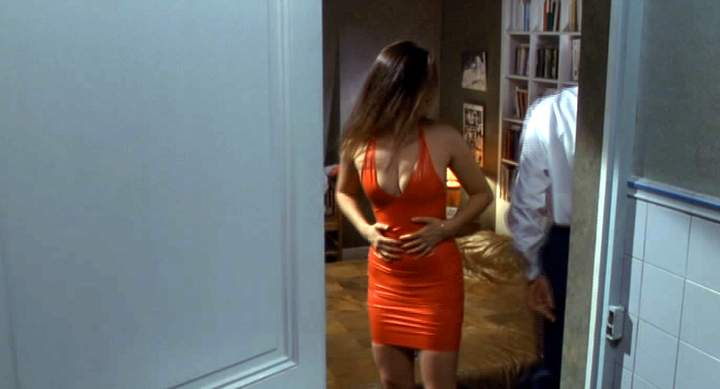
Reception and Controversy: A Polarizing Cult Classic
Bitter Moon divided critics, earning a 63% approval rating on Rotten Tomatoes from 35 reviews, averaging 6.2/10, and mixed praise . Roger Ebert gave it a positive review, noting its “wretched excess” but praising Polanski’s “uncompromising” direction, with audiences gripped despite critical condescension . Time Out called it “rich and darkly disturbing” yet “wickedly entertaining,” lauding its ironic comedy . The New York Times’ Janet Maslin found it “nasty, mocking, darkly subversive” but “never dull,” while Variety’s Derek Elley slammed it as “rock bottom,” citing an “all-over-the-map” script . Hollywood Screen & Stream in 2023 hailed it as Polanski’s “nastiest, most potent” later work, per web:19.
Audience reactions were equally split, with a 70% Popcornmeter on Rotten Tomatoes from 5,000+ ratings [web:3]. IMDb scores it 7.2/10 from 43,000 votes, with users like Rui praising its “masterpiece” status and Vangelis’s score, though others, like MERK, found it “shocking” but flawed . Letterboxd’s @cinephile99 calls Coyote’s “golden shower” monologue “pure cinema,” while @systemterror labels it “anti-Titanic” for subverting romance [web:5]. The film grossed $1.8 million in the U.S. and $8.9 million worldwide, a commercial failure against its budget, per The Numbers .
Controversy swirled around its explicit content—S&M, nudity, and scenes like Mimi’s ***—deemed “tasteless” by Variety . Polanski’s casting of Seigner, his wife, fueled accusations of self-indulgence, with Ebert noting critics’ discomfort with the “lurid” autobiographical hint [web:2,22]. Feminist critiques, per TV Tropes, debated Mimi’s objectification, though Letterboxd’s @filmlover88 sees her as a complex “sorcerer” . The film’s portrayal of a paraplegic’s humiliation, per Reddit’s u/widmerpool_nz, raised ethical questions, yet its dark comedy mitigated backlash [web:16]. Common Sense Media rates it 18+ for “***, nudity, violence, and language,” warning of its disturbing themes .
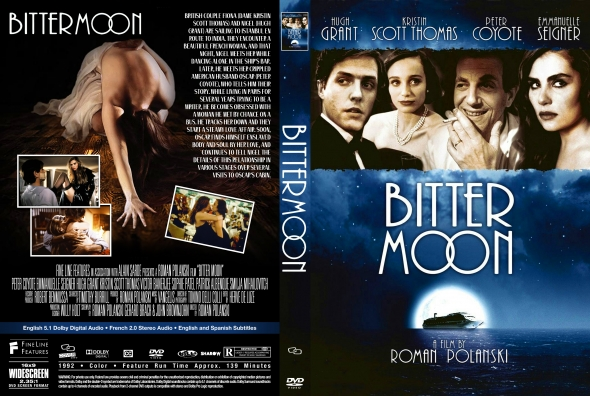
Cultural Significance: A 1990s Erotic Thriller Landmark
Bitter Moon premiered during the early 1990s peak of erotic thrillers, alongside Basic Instinct and Sliver (1993), reflecting a cultural fascination with sexual taboo post-1980s conservatism, per Film Comment. Released in Europe in 1992, amid Polanski’s exile from the U.S. due to legal controversies, it carried added scrutiny, as The Atlantic notes. Its Mediterranean cruise setting, evoking Knife in the Water (1962), reinforced Polanski’s claustrophobic motifs, per Time Out . The Paris flashbacks, with their bohemian allure, tapped into 1990s romanticized views of the city, per Luke Honey .
Compared to Save Me (1994), previously discussed, which uses low-budget noir to explore betrayal, Bitter Moon elevates the genre with Polanski’s auteurist flair, both featuring femme fatales (Mimi, Ellie) but differing in ambition and execution. Coyote’s performance solidified his character-actor status, while Seigner’s role, despite controversy, showcased her range, per IMDb [web:6]. Grant and Scott Thomas’s against-type roles prefigured their dramatic pivots, per Variety . The film’s influence is seen in later psychological thrillers like Gone Girl (2014), per Film Comment. Streaming on Prime Video and Tubi in 2025, per Amazon and JustWatch , it retains cult status, with X posts like @filmfreak22 calling it a “twisted masterpiece” .
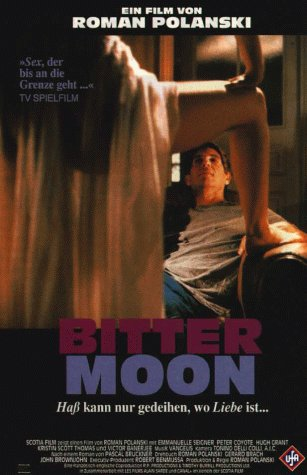
Legacy and Availability
Bitter Moon endures as a polarizing cult classic, celebrated for Polanski’s audacity, Coyote’s bravura, and Seigner’s allure, but debated for its excesses and ethical quandaries. Its 1994 VHS, 2002 DVD, and 2020 Blu-ray by Kino Lorber, with cast interviews, are collector favorites, per Amazon [web:22]. Academic analyses in Journal of Film and Video explore its psychoanalytic depth, while Letterboxd’s @systemterror hails its “anti-Titanic” irony .
As of May 23, 2025, Bitter Moon is available for streaming on Prime Video, Tubi, Pluto TV, and Kanopy (subject to regional availability), with English subtitles, per JustWatch [web:23]. Rental and purchase options exist on Amazon Video, Apple TV, Fandango at Home, and Google Play, per Reelgood . Physical DVD and Blu-ray copies are available through retailers like Amazon and Kino Lorber .

Conclusion: A Darkly Seductive Cinematic Voyage
Bitter Moon (1992) is a bold, provocative thriller that plunges viewers into the abyss of love’s darkest impulses, guided by Roman Polanski’s uncompromising vision. With Peter Coyote’s searing performance, Emmanuelle Seigner’s haunting allure, and Hugh Grant and Kristin Scott Thomas’s nuanced restraint, the film crafts a wickedly comic, deeply unsettling portrait of obsession and betrayal. Though its melodramatic flourishes and controversial themes divide audiences, its psychological depth, Vangelis’s evocative score, and cult status make it a standout in Polanski’s filmography. For fans of erotic thrillers, psychological dramas, or Polanski’s daring artistry, Bitter Moon offers an unforgettable journey—one that burns with passion and lingers like a bitter, intoxicating dream.